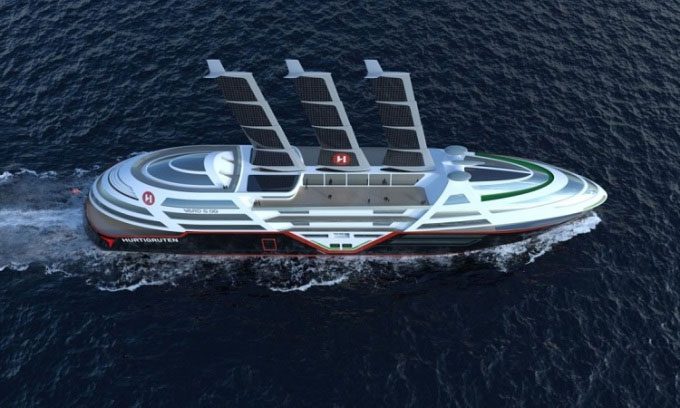Hurtigruten Introduces Electric Passenger Ship Model with Retractable Sails and Solar Panels, Set to Launch in 2030.

135m emissions-free ship model. (Photo: Hurtigruten).
Hurtigruten currently operates a fleet of 8 ships, each with a capacity of 500 passengers, cruising along the coastline of Norway from Oslo to the Arctic Circle. The company’s CEO, Hedda Felin, hopes that this new initiative will inspire the entire maritime industry. The project, named “Sea Zero”, was first announced in March 2022. Since then, alongside 12 partners and the SINTEF research institute, Hurtigruten has been exploring technological solutions to achieve emissions-free maritime transportation.
The design of Hurtigruten’s passenger ship will primarily rely on a 60-megawatt battery system that can be charged with clean energy at ports, as renewable energy accounts for 98% of Norway’s electricity system. Gerry Larsson-Fedde, Senior Vice President of Hurtigruten, estimates that the battery will have a range of 555 to 648 kilometers, meaning that on an 11-day round trip, the passenger ship will only need to recharge about 7 to 8 times.
To reduce dependence on the battery, three sails will rise from the deck when the wind is favorable, reaching a maximum height of 50 meters. These sails can be adjusted independently, lowered when passing under bridges, or angled for optimal wind capture. The trio of sails will cover a total of 1,500 square meters of solar panels, generating energy to supplement the battery. The amount of power in the battery will be displayed on the ship’s side. “In Norway, even though it can be dark in winter, the sun still shines in the south. The sun shines continuously all day in the summer,” Larsson-Fedde noted.
The ship will feature 270 cabins with a capacity for 500 passengers and 99 crew members. Its elongated shape reduces air resistance, contributing to lower energy consumption. Over the next two years, Hurtigruten will test the technological proposals before finalizing the design in 2026 and commencing production at the shipyard in 2027. The first ship is set to launch in Norway in 2030. Following this, the company hopes to gradually transition its entire fleet to emissions-free vessels.




















































